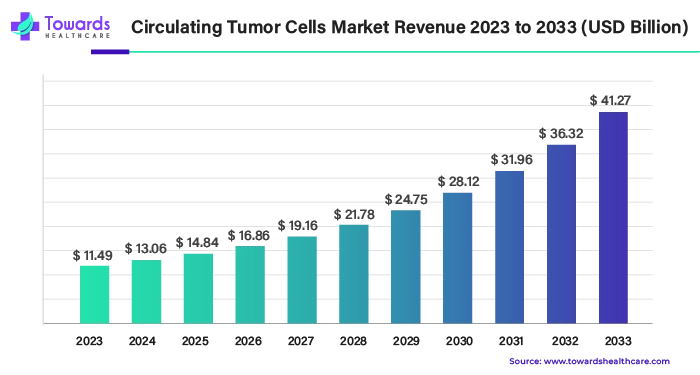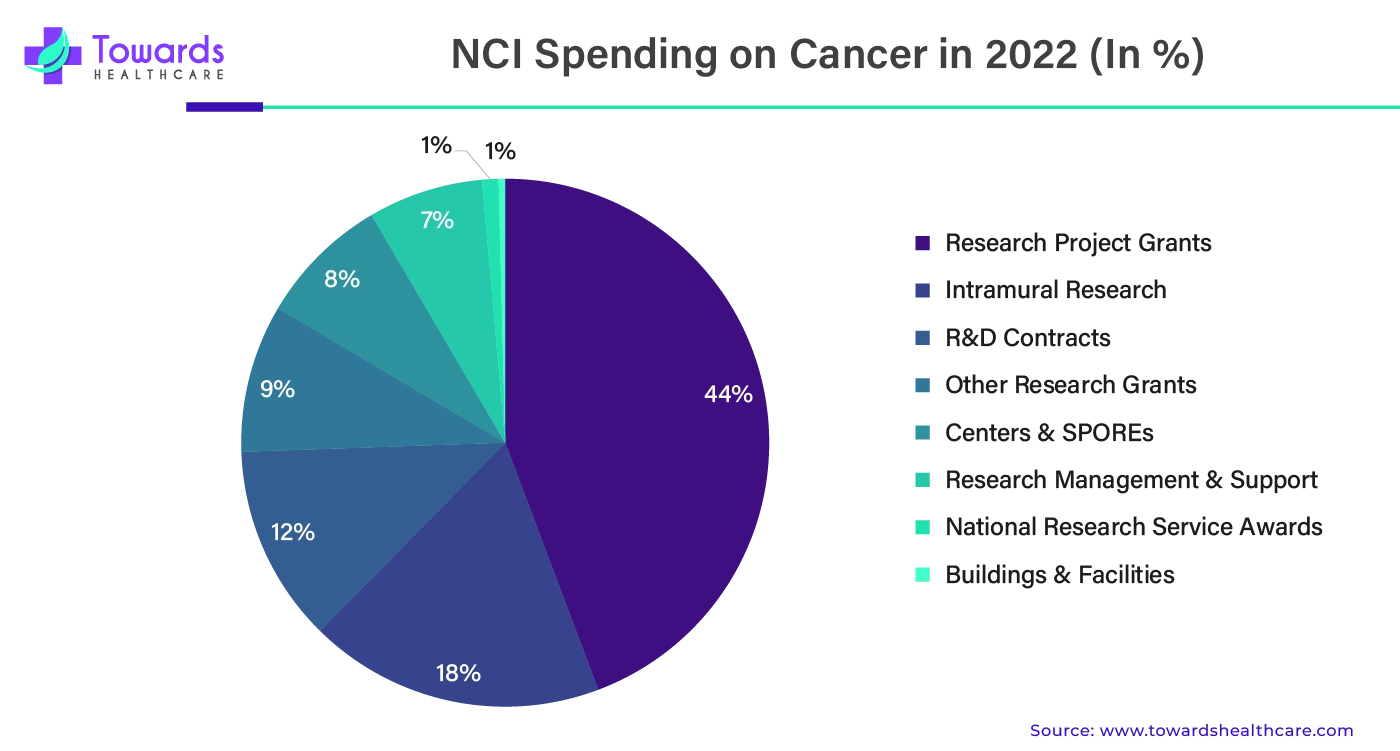December 2024

The global circulating tumor cells market size was estimated at US$ 11.49 billion in 2023 and is projected to grow US$ 41.27 billion by 2033, rising at a compound annual growth rate (CAGR) of 13.64% from 2024 to 2033. The growing prevalence of cancer drives the market’s growth.

Tumor cells that have separated from their parent tumor and become extravasive into the bloodstream are known as circulating tumor cells, or CTCs. The circulating tumor cells market is expanding quickly due to the enormous potential for target discovery against cancer metastasis that comes with comprehending the metastatic cascade of CTCs. The majority of CTC research to date has been on CTCs in the bloodstream. New methods of detecting CTCs have greatly advanced research into the biology of these cells and made it easier to use them in therapeutic settings. CTCs have made it easier to use CTCs in clinical settings for prognosis assessment, treatment response monitoring, and cancer screening.
| Company Name | Immunocore |
| Headquarters | Oxfordshire, United Kingdom |
| Pipeline | As of January 2024, patients with high-risk primary uveal melanoma that is HLA-A*02:01-positive and who have received final treatment by surgery or radiation therapy and show no signs of metastatic disease on imaging will be randomly assigned to locations in ten EU nations as well as the United States in this Phase 3 clinical study, which is being led by the EORTC. Relapse-free survival (RFS) is the main study outcome, with overall survival, tebentafusp safety, and tolerability being secondary goals. The comparison of health-related quality of life between the treatment arms and the assessment of circulating tumor DNA's potential as a biomarker for the existence of residual illness are two examples of exploratory purposes. |
| Company Name | Merck & Co. |
| Headquarters | New Jersey, U.S. |
| Pipeline | At present, the business is investigating the minimum residual disease in resected high-risk melanoma patients treated with mRNA-4157/V940, a tailored cancer vaccine, and pembrolizumab, using circulating tumor DNA as a biomarker of recurrence-free survival. M. Carlino. (Modera in Charge). |

One of the main causes of mortality in the globe is cancer. People are becoming more exposed to carcinogens due to a variety of circumstances, including pollution, improper eating habits, smoking, alcohol consumption, and changing environmental conditions. This is leading to an increase in the number of cancer patients and the expansion of the market for circulating tumor cells. Every form of cancer has a different treatment plan, so getting the diagnosis right is crucial to getting the right kind of care. Through liquid biopsy, the sensitive identification of CTCs from clinical samples can be a useful technique for cancer diagnosis and prognosis. For patients and their families to get pain management and palliative care, effective public health initiatives that include home and community-based care are crucial.
A large number of persons from lower- and middle-class families are unable to afford the necessary safeguards for cancer diagnosis because of the high cost of CTC. Due to the requirement for antibodies to bind to the CTCs in the blood, each sample has a high detection cost. A further factor contributing to the high cost of detection is the use of expensive ligands for CTC collection. According to Michigan Medicine's insurance billing, the current cost of the Circulating Tumor Cells (CTC) test is $2,689.00, which additionally includes $451.00 for a professional interpretation.
Oncologists have recently started to use machine learning extensively to create prediction models with better performance in order to assist clinical choices. New advances in artificial intelligence may enable computers to "learn" possible trends from historical databases. According to a number of studies, machine learning algorithms like decision trees and neural networks are crucial for determining a cancer patient's risk level.
With the use of blood factors, such as circulating tumor cells, machine learning algorithms might stratify EOC patients based on risk prior to the first intervention. With their potential to stratify EOC patients before therapy, the prediction algorithms may provide individualized treatment approaches. Using ensemble learning, result integration, and overall prediction, Random Forest—a machine learning algorithm built around the decision tree as its fundamental building block—is able to autonomously train a number of very weak learning models.
By technology, the CTC detection & enrichment methods segment dominated the circulating tumor cells market in 2023. Many techniques have been developed to increase the sensitivity of detection while also increasing the yield and purity of CTC enrichment. As such, the presence of CTCs in blood or disseminated tumor cells (DTCs) in bone marrow can be used to identify individuals who are at high risk of metastasis. Researchers have recently focused their efforts on creating new and/or enhanced CTC detection techniques by leveraging automation and technological advancements in cutting-edge fields like microfluidics and nanotechnology. This is done in an effort to increase yields, sensitivity, and specificity, as well as the possibility of downstream analysis. With the advancement of artificial intelligence (AI) and machine learning, a new and rapidly developing chapter in medical research has begun. This work has improved the objectivity and speed of finding rare cells.
By technology, the CTC analysis segment is expected to register the fastest CAGR from 2024 to 2033. The examination of CTCs in clinical blood samples involves the two critical steps of isolation and identification. Since CTCs are rare, single-cell research focuses on transcriptome and genome analysis, where accurate genetic information may be collected by controlling the byproducts of amplification that are peculiar to CTCs. Prognostic monitoring and cancer detection also depend on the analysis of protein expression in a limited number of CTCs. The biological characteristics of the metastatic tumors may be accurately determined, allowing for the genetic analysis of numerous CTC phenotypes associated with EMT.
By application, the research segment held the largest circulating tumor cells market share in 2023. Researching the molecular and functional properties of CTCs may yield comprehensive understanding of extremely deadly tumor illnesses. In order to increase the sensitivity and specificity of the collection and detection of CTCs in cancer patients' whole blood, researchers are designing tools and developing analytical techniques.
By application, the clinical/liquid biopsy segment is anticipated to grow at the fastest rate during the forecast period. A blood test called a liquid biopsy can identify malignant tumor markers, such as tumor cells and DNA from diseased cells. Presently available tests authorized by the US FDA can assist doctors in deciding what course of therapy to take, identifying some types of advanced malignancies, and estimating prognosis. Liquid biopsy has demonstrated significant promise in recent years for enhancing cancer detection and therapy. Investigations on possible applications for liquid biopsy diagnostics are still underway.
By product, the kits & reagents segment dominated the circulating tumor cells market in 2023. Prepackaged reagent kits with all the components needed for certain chemical analyses or tests are widely used in diagnostics and laboratories to standardize and expedite processes. To guarantee precise and repeatable findings, reagent kits usually include all the necessary chemicals, instructions, and occasionally specialized equipment. Assays related to biochemistry, molecular biology, and analytical techniques are performed extensively in domains such as environmental testing, clinical diagnostics, and research laboratories. There are several commercial tools, kits, and reagents available for this use, such as the OncoQuick and Ficoll-Hypaque systems. A set of staining and fixing chemicals is included in the CTC kit for the CTC enumeration stage.
By product, the devices segment is estimated to grow at the fastest CAGR during the forecast period. In order to ascertain the molecular and functional heterogeneity of CTCs, current methods for the separation and investigation of CTC biology include the use of microfluidic devices, single-cell sequencing, and the integration of multi-omics data. To assist in the identification of biomarkers and possible treatment targets, machine learning techniques that have been taught to analyze complicated CTC data are also being created.
By specimen, the blood specimen segment dominated the circulating tumor cells market in 2023. The growth and fragmentation of malignant tumors into cells and tissue mass allow the malignancies to spread to other areas and enter circulation. The blood becomes a very helpful resource for the identification of CTC as the cells move through the circulation. Currently, a variety of tumor-associated cell types may be seen in cancer patients' peripheral blood; circulating tumor cells (CTCs) are the most well-known of them. Peripheral blood is a significant source of cancer-derived components that are useful for cancer detection and tracking.
By specimen, the bone marrow segment is estimated to register the fastest CAGR during the forecast period. An exceptional chance to improve the effectiveness of capturing individual tumor cells following cancer resections is provided by the sampling of blood and bone marrow compartments. It's possible that blood-borne DTCs are stored in the bone marrow. Individual tumor cells have been found and identified in blood, bone marrow, and other organs. These findings have significant therapeutic care implications for oncologic patients as well as fresh insights into the intricate biology of tumors.
By region, North America dominated the protein labeling circulating tumor cells market in 2023. North America has one of the most advanced healthcare systems, along with key players, which continuously contribute to research and development and promote CTC diagnosis and treatment. The U.S. and Canada majorly contribute to the growth of the region.

Due to its sophisticated technology, government backing, and the existence of several important companies, the U.S. leads the world market for circulating tumor cells. NCI will receive a total amount of $7.22 billion under the Further Consolidated Appropriations Act, 2024 (H.R.2882), an increase of $120 million over the interim budget allocated by the Continuing Resolution. 2023 is the last year of fresh funding for the Cancer Moonshot's National Cancer Institute (NCI), providing an extra $216 million. There would be a net reduction of $96 million in NCI funding for FY 2024 as compared to FY 2023.
Furthermore, both domestically and internationally, cancer has a significant influence on the U.S. The statistics on cancer depict the disease's impact on society across time and explain what happens to vast populations of individuals. 611,720 Americans are expected to lose their lives to cancer in 2024, while 2,001,140 new cases are predicted to be identified in the US. As of 2024, 48% of all malignancies diagnosed in males were anticipated to be colorectal, lung, and prostate cancers. By 2024, colorectal, lung, and breast cancers will account for 51 percent of all new cancer diagnoses in women. These three types of malignancies are the most frequent among women. 14,910 children and teenagers between the ages of 0 and 19 are predicted to receive a cancer diagnosis in 2024, and 1,590 of them will pass away from the illness. In 2020, the United States is expected to spend $208.9 billion on cancer care on a national scale. With the aging population and rising cancer rates, prices are expected to rise in the coming years. The adoption of new, frequently more costly therapies as a standard of care will also probably result in higher costs.
By region, Asia Pacific is estimated to showcase the fastest growth during the forecast period. The healthcare demands of approximately two-thirds of the world's population who live in the APAC region, especially in China—are changing. Due to a growing middle class throughout the area, rising disposable incomes are also driving up healthcare costs. The surge is also being fueled by government programs. By 2030, the country's healthcare business is expected to have grown to be worth over US$2.4 trillion, nearly doubling in size in only ten years, according to the Healthy China 2030 project. The last five years have seen a growth of more than a fifth in the Indian healthcare sector. India is becoming a new center for healthcare due to three factors: rising spending on both public and private healthcare, a flourishing pharmaceutical industry, and a changing ecosystem of healthcare technologies.
By Technology
By Application
By Product
By Specimen
By Regional
December 2024
December 2024
December 2024
August 2024